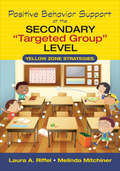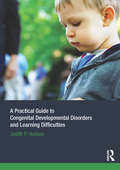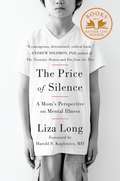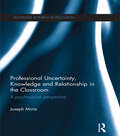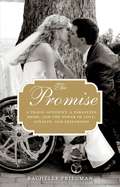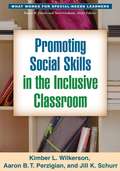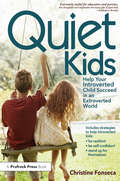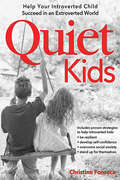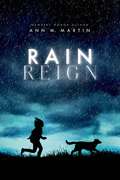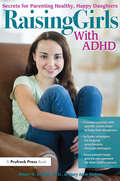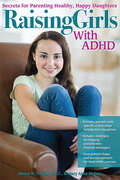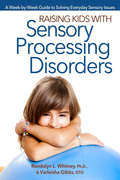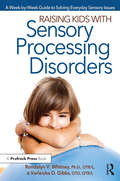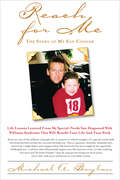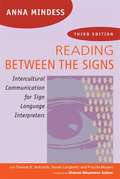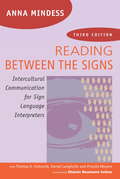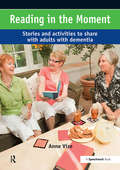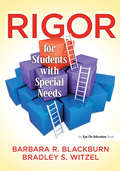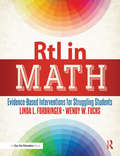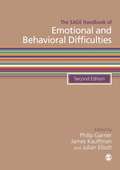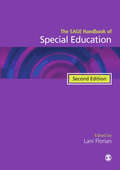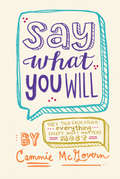- Table View
- List View
Positive Behavior Support at the Secondary "Targeted Group" Level: Yellow Zone Strategies
by Laura A. Riffel Melinda S. MitchinerSeal the gaps in student learning with targeted intervention Research on positive behavior support has focused largely on tier one, school-wide disciplinary policies, and tier three interventions tailored to highly problematic students. This leaves a gap in the middle. "Yellow zone", or tier two, interventions are an extremely effective way to address many challenging behavior and disciplinary issues in small group settings. Positive Behavior Support at the Secondary "Targeted Group" Level shows teachers how to identify the students who can benefit from tier two interventions and demonstrates how to create an implementation plan that delivers results. Focusing on proactive strategies rather than reactive solutions, Riffel and Mitchiner’s research-based techniques include: General strategies that can be applied at the individual student level, such as self-management, proximity control, and the Premack principle and peer mentoring Comprehensive action plans that anticipate the full range of disruptions that may occur A useful behavior rating sheet proven effective in improving student behavior "Funk Sway" For The Classroom: Using Feng Shui principles to create a classroom environment that enhances productivity, learning, and creativity Apply the techniques in this book to reduce challenging behavior, improve school climate, and improve outcomes for ALL students. "This book is easy to read, understand, and implement in any classroom or school. Teachers will be drawn to the resources that can be copied and used immediately! I can’t wait to apply some of these practices in my classroom!" Rachel Spenner, Sixth Grade Teacher Westridge Elementary School
Positive Behavior Support at the Secondary "Targeted Group" Level: Yellow Zone Strategies
by Laura A. Riffel Melinda S. MitchinerSeal the gaps in student learning with targeted intervention Research on positive behavior support has focused largely on tier one, school-wide disciplinary policies, and tier three interventions tailored to highly problematic students. This leaves a gap in the middle. "Yellow zone", or tier two, interventions are an extremely effective way to address many challenging behavior and disciplinary issues in small group settings. Positive Behavior Support at the Secondary "Targeted Group" Level shows teachers how to identify the students who can benefit from tier two interventions and demonstrates how to create an implementation plan that delivers results. Focusing on proactive strategies rather than reactive solutions, Riffel and Mitchiner’s research-based techniques include: General strategies that can be applied at the individual student level, such as self-management, proximity control, and the Premack principle and peer mentoring Comprehensive action plans that anticipate the full range of disruptions that may occur A useful behavior rating sheet proven effective in improving student behavior "Funk Sway" For The Classroom: Using Feng Shui principles to create a classroom environment that enhances productivity, learning, and creativity Apply the techniques in this book to reduce challenging behavior, improve school climate, and improve outcomes for ALL students. "This book is easy to read, understand, and implement in any classroom or school. Teachers will be drawn to the resources that can be copied and used immediately! I can’t wait to apply some of these practices in my classroom!" Rachel Spenner, Sixth Grade Teacher Westridge Elementary School
A Practical Guide to Congenital Developmental Disorders and Learning Difficulties
by Judith P. HudsonTo give children with congenital developmental conditions that manifest special learning needs and specific disabilities their best chance to succeed, early identification and appropriate interventions and support, is necessary. This text highlights what to look for when there are concerns about a child’s development. Practical and accessible, it is divided into three sections: Part 1 looks at the theory and policy context, discussing the social model of disability, the responsibility of health, social care and education services to the child and family and the role of reviews and assessment in recognising developmental disorders. Part 2 provides a reference guide to atypical developmental conditions and disorders. For each condition, aetiology, prominent theories and research, profile of features – including triggers and behaviours, diagnostic assessment procedures and appropriate interventions are given and links made to sources of further information and support. Part 3 explores practical issues how to work sensitively and effectively with children and their families, looking at the psychological implications of diagnosis, and how to plan, promote, deliver and evaluate multi-agency support. Designed to support professionals working within a multi-modal, collaborative approach to assessment and intervention processes, it is suitable for health visitors, allied health therapists, nurses, teachers and social care practitioners. It is also a useful reference for students in these areas learning about child development and includes critical reading exercises; online searching tasks; self-assessment questions; reflective activities and document analysis prompts.
The Price of Silence
by Liza Long Harold KoplewiczLiza Long is the mother of a child who has bipolar disorder. When she heard about the Newtown shooting, her first thought was, "What if my son does that someday?" She wrote an emotional response to the tragedy, which the Boise State University online journal published as "I Am Adam Lanza's Mother." The post went viral, receiving 1.2 million Facebook likes, nearly 17,000 tweets, and 30,000 emails.Now, in The Price of Silence, she takes a devastating look at how we address mental illness, especially in children, who are funneled through a system of education, mental healthcare, and juvenile detention that leads far too often to prison. In the end she asks one central question: If there's a poster child for cancer, why can't there be one for mental illness? The answer: stigma. She is speaking in a way that we cannot help but hear, and she won't stop until something changes.
The Price of Silence
by Liza Long Harold KoplewiczLiza Long is the mother of a child who has bipolar disorder. When she heard about the Newtown shooting, her first thought was, "What if my son does that someday?" She wrote an emotional response to the tragedy, which the Boise State University online journal published as "I Am Adam Lanza's Mother." The post went viral, receiving 1.2 million Facebook likes, nearly 17,000 tweets, and 30,000 emails. Now, in The Price of Silence, she takes a devastating look at how we address mental illness, especially in children, who are funneled through a system of education, mental healthcare, and juvenile detention that leads far too often to prison. In the end she asks one central question: If there's a poster child for cancer, why can't there be one for mental illness? The answer: stigma. She is speaking in a way that we cannot help but hear, and she won't stop until something changes.
Professional Uncertainty, Knowledge and Relationship in the Classroom: A psychosocial perspective (Routledge Research in Education)
by Joseph MintzThe extent to which teachers should make use of theoretical and expert knowledge as opposed to tacit experiential knowledge, and how these might be combined, is a perennial issue in discussions on pedagogy. This book addresses these debates through a creative development of the concept of productive uncertainty.Using case studies focusing on teachers working with children with autism, a particularly fertile crucible for considering uncertainty, the book explores how the radical 20th century psychoanalyst Wilfred Bion's epistemological approach to uncertainty can be used to re-frame Donald Schön's concept of reflection in action, offering a new perspective on the practice of teachers and other caring professionals. Several areas of potential uncertainty are identified, including uncertainty relating to areas of practice including diagnosis, the relationship between expert knowledge and practice, the implications of autism for autonomy and agency, and uncertainties in relation to the understanding of and use of new technologies. A strong argument is made, based on both theoretical and empirical grounds, that in juggling between theoretical and tacit knowledge in the classroom there is more to be gained by staying with the struggle with uncertainty than by fleeing from it too early, into the promise of expert solutions. Consideration is also given to the relative importance of specific theoretical training for teachers, both in general and in relation to working with children with special educational needs, in the context of international and UK policy developments in this area.This book will be of key value to researchers and postgraduates in the fields of education studies, teacher thinking and research, psychoanalytically informed psychosocial studies, as well as to practitioners working in special educational needs/autism education.
The Promise: A Tragic Accident, a Paralyzed Bride, and the Power of Love, Loyalty, and Friendship
by Rachelle FriedmanRachelle Friedman describes her life before and after her accident which leaves her paralyzed. In spite of the serious nature of her accident, she is able to form a new life. In this true story, she shows how the love of her friends, family, and inner strength helped her to recover from the emotional trauma and help others.
Promoting Social Skills in the Inclusive Classroom
by Jill K. Schurr Aaron B. Perzigian Kimber L. WilkersonThis indispensable book presents evidence-based tools and strategies for improving the social skills of all members of the inclusive classroom (K-6), especially students experiencing difficulties in this area. The authors explain why social competence is critical to school success and describe interventions, curricula, and instructional approaches that have been shown to be effective at the schoolwide, classroom, and individual levels. Procedures for conducting assessments and developing individualized intervention plans are detailed. Reproducible forms can be downloaded and printed in a convenient 8 1/2" x 11" size.
Quiet Kids: Help Your Introverted Child Succeed in an Extroverted World
by Christine FonsecaBeing an introverted child is difficult, especially in an ever-increasingly noisy world. Often viewed as aloof, unmotivated, or conceited, introverted children are deeply misunderstood by parents, educators, and even their peers. That's where Quiet Kids: Help Your Introverted Child Succeed in an Extroverted World comes in. Designed to provide parents with a blueprint for understanding the nature of introversion, Quiet Kids provides specific strategies to teach children how to thrive in a world that may not understand them. Presented in an easy-to-read, conversational style, the book uses real-world examples and stories from introverts and parents to show parents and educators how to help children develop resiliency and enhance the positive qualities of being an introvert. With specific strategies to address academic performance, bullying, and resiliency, Quiet Kids is a must-read for anyone wishing to enhance the lives of introverted children.
Quiet Kids
by Christine FonsecaBeing an introverted child is difficult, especially in an ever-increasingly noisy world. Often viewed as aloof, unmotivated or conceited, introverted children are deeply misunderstood by parents, educators and even their peers. That's where Quiet Kids: Help Your Introverted Child Succeed in an Extroverted World comes in. Designed to provide parents with a blueprint for not only understanding the nature of introversion, Quiet Kids provides specific strategies to teach their children how to thrive in a world that may not understand them. Presented in an easy-to-read, conversational style, the book uses real-world examples and stories from introverts and parents to show parents and educators how to help children develop resiliency and enhance the positive qualities of being an introvert. With specific strategies to address academic performance, bullying, and resiliency, Quiet Kids is a must read for anyone wishing to enhance the lives of introverted children.
Rain Reign
by Ann M. MartinWinner of the Schneider Family 2015 Middle School Award<P><P> Rose Howard is obsessed with homonyms. She's thrilled that her own name is a homonym, and she purposely gave her dog Rain a name with two homonyms (Reign, Rein), which, according to Rose's rules of homonyms, is very special. Not everyone understands Rose's obsessions, her rules, and the other things that make her different - not her teachers, not other kids, and not her single father.<P> When a storm hits their rural town, rivers overflow, the roads are flooded, and Rain goes missing. Rose's father shouldn't have let Rain out. Now Rose has to find her dog, even if it means leaving her routines and safe places to search.<P> Hearts will break and spirits will soar for this powerful story, brilliantly told from Rose's point of view.
Raising Girls With ADHD: Secrets for Parenting Healthy, Happy Daughters
by James W. Forgan Mary Anne RicheyAlthough an increasing number of girls are diagnosed with ADHD every year, most of the focus of parent and teacher interventions has been on boys, leaving girls with ADHD frustrated and prone to acting out. Written by two professionals who have “been there and done that” with their own children with ADHD, Raising Girls With ADHD provides expert information to empower parents to make decisions about identification, treatment options, behavioral strategies, personal/social adjustment, educational impact, and many other issues from preschool through high school. These girls' struggles with socialization and peer acceptance, executive functioning skills like memory and organization, and emotional well-being and self-confidence are discussed with a goal of maximizing strengths and providing supports for weaknesses. Complete self-reflection surveys and action steps for parents and girls alike are included to create a dynamic action plan for your daughter's success in school and beyond.
Raising Girls with ADHD
by James Forgan Mary Anne RicheyAlthough an increasing number of girls are diagnosed with ADHD every year, most of the focus of parent and teacher interventions has been on boys, leaving girls with ADHD frustrated and prone to acting out. Written by two professionals who have "been there and done that" with their own children with ADHD, Raising Girls with ADHD provides expert information to empower parents to make decisions about identification, treatment options, behavioral strategies, personal/social adjustment, educational impact, and many other issues from preschool through high school. These girls' struggles with socialization and peer acceptance, executive functioning skills like memory and organization, and emotional well-being and self-confidence are discussed with a goal of maximizing strengths and providing supports for weaknesses. Complete self-reflection surveys and action steps for parents and girls alike are included to create a dynamic action plan for your daughter's success in school and beyond.
Raising Kids With Sensory Processing Disorders: A Week-by-week Guide To Solving Everyday Sensory Issues
by Rondalyn V. WhitneyWhether it's having to remove tags from clothing or using special dimmed lighting when they study, kids with sensory disorders or special sensory needs often need adaptations in their everyday lives in order to find success in school and beyond. Taking a look at the most common sensory issues kids face, Raising Kids with Sensory Processing Disorders offers a compilation of unique, proven strategies parents can implement to help their children move beyond their sensory needs and increase their performance on tasks like homework, field trips, transitions between activities, bedtime, holidays, and interactions with friends. Written by a parent of two children with very different sensory needs, the book shows parents how to characterize their child's sensory issues into one of several profiles that they can then use to find the best adaptations and changes to their everyday routines.
Raising Kids With Sensory Processing Disorders: A Week-by-Week Guide to Solving Everyday Sensory Issues
by Rondalyn V Whitney Varleisha GibbsWhether it's having to remove tags from clothing or using special dimmed lighting when they study, kids with sensory disorders or special sensory needs often need adaptations in their everyday lives in order to find success in school and beyond. Taking a look at the most common sensory issues kids face, Raising Kids with Sensory Processing Disorders offers a compilation of unique, proven strategies parents can implement to help their children move beyond their sensory needs and increase their performance on tasks like homework, field trips, transitions between activities, bedtime, holidays, and interactions with friends. Written by a parent of two children with very different sensory needs, the book shows parents how to characterize their child's sensory issues into one of several profiles that they can then use to find the best adaptations and changes to their everyday routines.
Reach for Me: The Story of My Son Connor
by Michael A. BoylanParents and related caregivers of children with special needs have been handed lifelong challenges that test their very fabric as people. Continuous stress, worry and anxiety can be the norm throughout their lives. It&’s hard to relax. Imagine that—not being able to relax or take a break. Every parent of a special-needs child should read this story. It will bring them hope and encouragement. If you are not a caregiver, give Reach for Me to someone who is! Your gesture will acknowledge the challenges they cope with on a daily basis, helping them find inspiration to carry on.
Reaching and Teaching Students with Special Needs through Art
by Beverly Levett Gerber Doris M. GuayThis book has played an important role in reaching and teaching special needs students; its compiled in a simple manner to provide access to its audience. It contains practices, research, and the rationale for art in the education of students with special needs.
Reading Between the Signs: Intercultural Communication For Sign Language Interpreters
by Anna MindessIn Reading Between the Signs, Anna Mindess provides a perspective on a culture that is not widely understood-American Deaf culture. With the collaboration of three distinguished Deaf consultants, Mindess explores the implications of cultural differences at the intersection of the Deaf and hearing worlds. Used in sign language interpreter training programs worldwide, Reading Between the Signs is a resource for students, working interpreters and other professionals. This important new edition retains practical techniques that enable interpreters to effectively communicate their clients' intent, while its timely discussion of the interpreter's role is broadened in a cultural context.NEW TO THIS EDITION: New chapter explores the changing landscape of the interpreting field and discusses the concepts of Deafhood and Deaf heart. This examination of using Deaf interpreters pays respect to the profession, details techniques and shows the benefits of collaboration.
Reading Between the Signs: Intercultural Communication for Sign Language Interpreters
by Anna MindessIn Reading Between the Signs, Anna Mindess provides a perspective on a culture that is not widely understood - American Deaf culture. With the collaboration of three distinguished Deaf consultants, Mindess explores the implications of cultural differences at the intersection of the Deaf and hearing worlds. Used in sign language interpreter training programs worldwide, Reading Between the Signs is a resource for students, working interpreters and other professionals. This important new edition retains practical techniques that enable interpreters to effectively communicate their clients' intent, while its timely discussion of the interpreter's role is broadened in a cultural context. NEW TO THIS EDITION: New chapter explores the changing landscape of the interpreting field and discusses the concepts of Deafhood and Deaf heart. This examination of using Deaf interpreters pays respect to the profession, details techniques and shows the benefits of collaboration.
Reading in the Moment: Activities and Stories to Share with Adults with Dementia
by Anne VizeStudies have shown that reading in a melodic and rhythmic voice can produce positive changes in mood, emotion and behaviour in those with dementia. This book features: a detailed section on the background of how and what to read to those with dementia, as well as the research behind bibliotherapy.
Rigor for Students with Special Needs
by Barbara R. Blackburn Bradley S. WitzelThis practical, easy-to-read guide explains how to raise the rigor for students with special needs so they can achieve higher levels of learning. Learn how to set clear goals and expectations establish a climate of success scaffold and model lessons use graphic organizers and "think-alouds" apply modifications and accommodations use rigorous questioning strategies differentiate instruction increase family involvement Get even more out of this book by discussing it with others! It’s ideal for study groups and the appendix features a detailed guide on how to make it work for your group! Bonus! You get a great variety of handy black line masters for use in your own classroom.
RtI in Math: Evidence-Based Interventions for Struggling Students
by Wendy Fuchs Linda ForbringerLearn how to help K–8 students who struggle in math. This book provides a variety of clear, practical strategies that can be implemented right away to boost student achievement. You will find out how to design lessons that work with struggling learners, implement the recommendations for math intervention from the What Works Clearinghouse, use praise and self-motivation more effectively, develop number sense and computational fluency, teach whole numbers and fractions, increase students’ problem-solving abilities, and more! Extensive examples are provided for each strategy, as well as lesson plans, games, and resources.
The SAGE Handbook of Emotional and Behavioral Difficulties
by James Kauffman Professor Julian Elliot Professor Philip Garner'This important revision with updated material will inform professionals, students, and the interested public of evolving international perspectives on EBD. New chapters consider causation, the influence and role of social contexts and social support, ADHD, teacher knowledge and parental engagement. The new content presents us with fresh ideas and approaches.' - Katherine Bilton, University of Alaska, USA This new edition of The Handbook of Emotional and Behavioural Difficulties, first published in 2004, has been completely reworked and refreshed by a new editorial team led by Philip Garner. A thorough revision of existing content, together with new material, bring the volume firmly up-to-date, and offers guidance and recommendations for future research and practice. Covering a range of important issues in EBD, chapters are organized into five main parts: Contexts, Definitions and Terminologies Roots, Causes and Allegiances Strategies and Interventions Training and Professional Development Enhancement EBD Futures - Challenges and Opportunities With an impressive array of UK, US and other international contributors, the Handbook will be indispensable for undergraduate and Master's level students pursing Teacher Training, Educational and Developmental Psychology and Special Education courses. It will also be valuable to social workers, counsellors, school (educational) psychologists and other practitioners in relevant fields.
The SAGE Handbook of Special Education: Two Volume Set
by Lani FlorianThe second edition of The SAGE Handbook of Special Education provides a comprehensive overview of special education, offering a wide range of views on key issues from all over the world. The contributors bring together up-to-date theory, research and innovations in practice, with an emphasis on future directions for the role of special education in a global context of inclusion. This brand new edition features: " New chapters on families, interagency collaboration and issues of lifelong learning " The UN Convention on the Rights of Persons with Disabilities " Policy reform proposals " Equity and social justice in education " The impact of new thinking on assessment " Issues and developments in classification " The preparation and qualifications that teachers need The Handbook's breadth, clarity and academic rigour will make it essential reading for researchers and postgraduate students, and also for practitioners, teachers, school managers and administrators.
Say What You Will
by Cammie Mcgovern<P>John Green's The Fault in Our Stars meets Rainbow Rowell's Eleanor & Park in this beautifully written, incredibly honest, and emotionally poignant novel. Cammie McGovern's insightful young adult debut is a heartfelt and heartbreaking story about how we can all feel lost until we find someone who loves us because of our faults, not in spite of them. <P>Born with cerebral palsy, Amy can't walk without a walker, talk without a voice box, or even fully control her facial expressions. Plagued by obsessive-compulsive disorder, Matthew is consumed with repeated thoughts, neurotic rituals, and crippling fear. Both in desperate need of someone to help them reach out to the world, Amy and Matthew are more alike than either ever realized. <P>When Amy decides to hire student aides to help her in her senior year at Coral Hills High School, these two teens are thrust into each other's lives. As they begin to spend time with each other, what started as a blossoming friendship eventually grows into something neither expected, they realize that they tell each other everything--except the one thing that matters most.
